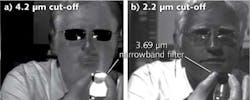IR IMAGING: Imager combines SWIR and MWIR sensitivity
Manijeh Razeghi and her group at Northwestern University (Evanston, IL) have created a new, high-performance infrared (IR) imager that combines detection in both the shortwave and midwave IR (SWIR and MWIR) in one device—a quality particularly valuable for tracking and reconnaissance.1 The device is based on a III-V semiconductor-based type-II indium arsenide/gallium antimonide (InAs/GaSb) superlattice (T2SL) structure, which previously had only been implemented for MWIR and longwave IR (LWIR).
Each pixel is made of an MWIR single heterodiode grown on top of a p-i-n SWIR homodiode, all fabricated on a GaSb substrate, which is subsequently removed for backside illumination (meaning the SWIR layer is on top). Crucially, the residual InAsSb etch-stop layer is also removed, using a citric-acid-based solution that etches away a specially inserted GaSb layer, eliminating the problem of the 4 μm InAsSb absorption-band edge.
The prototype focal-plane array (FPA) has 320 × 256 pixels. The average external quantum efficiency (QE) in the 2 to 4 μm wavelength range for the MWIR detectors was measured to be about 45%; a reference device without the InAsSb layer removed showed a much lower QE of about 25%. The SWIR detectors showed a much more dramatic jump in QE when the InAsSb layer was removed—from about 5% to 30%.
The researchers discovered that if the GaSb etch-stop layer is also removed, the QE in the near-IR (NIR) below 1.7 μm is greatly boosted; however, the absence of the GaSb layer also results in crosstalk between the MWIR and SWIR detector signals. As a result, they left the GaSb layer in and plan to further investigate the phenomenon.
When tested at various temperatures (with the aid of a cold shield), the FPA showed good MWIR performance at up to 140 K based on the noise-equivalent difference in temperature (NEDT). The limiting factor at 140 K was the dark current. For the SWIR channel, the dark noise measured with the cold shield over 100 frames was invariant below 150 K and was in good agreement with modeled noise sources.
Images were taken with the dual-band SWIR and MWIR FPA using a lens with transmission from about 1 to 5 μm. An imaged heat gun and graduate student clearly show the differences in SWIR and MWIR wavelength response (see figure).
Uses of high-temperature FPAs
As for uses, images like this are needed in a number of crucial military applications such as soldier night-vision goggles, weapon sights, and so on, notes Razeghi. Tracking and recognition of targets require highly sensitive and uniform FPAs operating at high temperatures (greater than 150 K).
“When this is realized in a multiband FPA sensing the SWIR and MWIR in a spatially coincident fashion and all-in-one package, the additional spectral band allows improved target discrimination, and detection of chemical signatures specific to a waveband (for example, carbon dioxide in the MWIR), that are otherwise not possible with single-band imagers,” she says. “In addition, the combination of SWIR and MWIR detection bands provides the flexibility to perform active and passive imaging in a single camera. The reflective nature of SWIR light allows detailed and high-contrast objects and shadows similar to the visible spectrum that can be obtained by illuminating a light source or under the night-sky radiance known as ‘night glow.’ Under low-light conditions or situations where use of a light source is prohibitive, the MWIR imaging may prove to be more useful without requiring active illumination. Therefore, a dual-band SWIR/MWIR camera can be considered as a multifunctional imaging device that is necessary in modern day warfare.”
Future plans include the fabrication of larger FPAs (such as 512 × 640 pixels) with higher angular resolution and/or larger field of view; improving performance by decreasing crosstalk between the MWIR and SWIR channels, minimizing the noise, and maximizing the detectivity; and increasing the FPA operating temperature.
“Currently, the operating temperature of SWIR/MWIR Type-II superlattice-based FPAs is limited by the MWIR channel,” says Razeghi. “By improving MWIR photodiode design, we can operate this type of FPA at higher temperatures; thus, the required cooling power will be decreased, which results in a lighter and cheaper camera. This kind of camera will be more suitable for portable applications such as helmet-mounted imaging systems.”
REFERENCE
1. E.K. Huang et al., Opt. Lett., 38, 1, 22 (Jan. 1, 2013).
About the Author
John Wallace
Senior Technical Editor (1998-2022)
John Wallace was with Laser Focus World for nearly 25 years, retiring in late June 2022. He obtained a bachelor's degree in mechanical engineering and physics at Rutgers University and a master's in optical engineering at the University of Rochester. Before becoming an editor, John worked as an engineer at RCA, Exxon, Eastman Kodak, and GCA Corporation.

